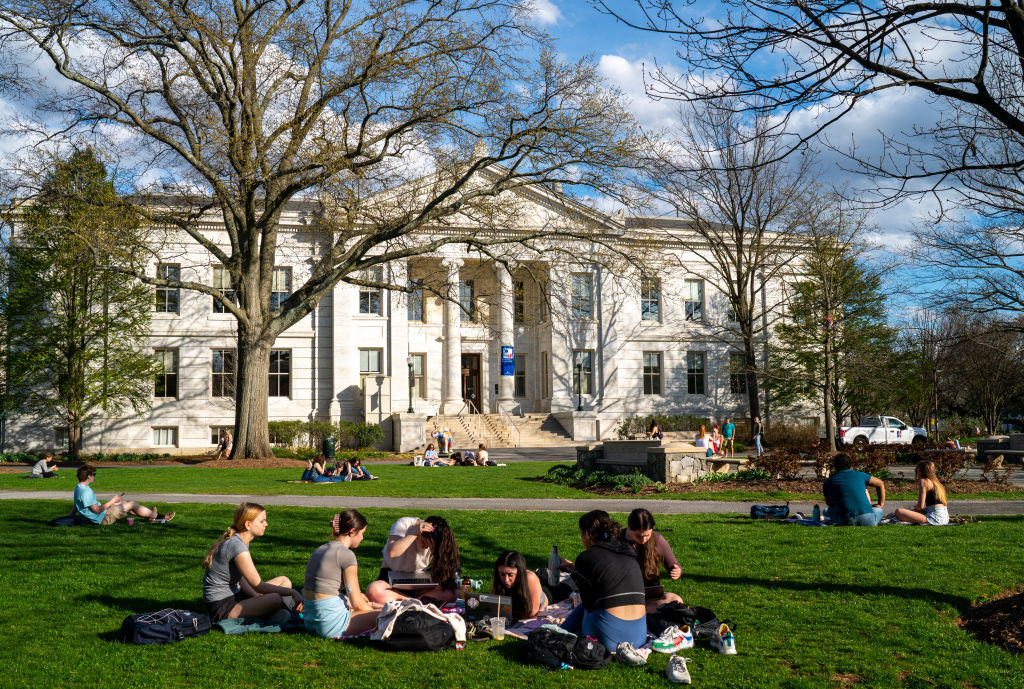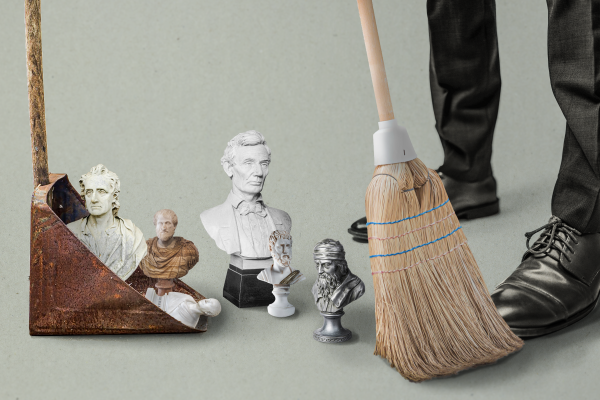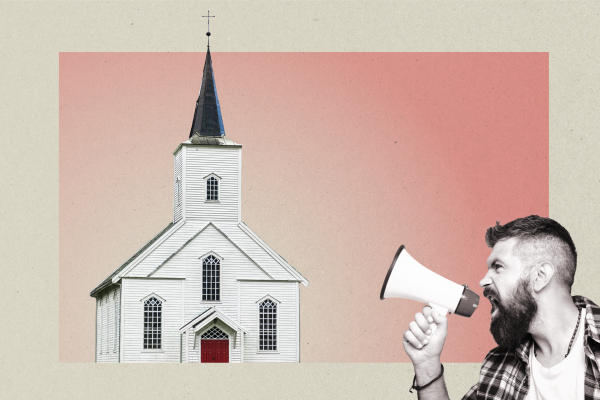Talk about fortuitous timing. Just weeks after author and journalist Will Bunch published his new book, After the Ivory Tower Falls: How College Broke the American Dream and Blew Up Our Politics and How to Fix It, President Joe Biden announced his student debt relief plan.
In After the Ivory Tower Falls, Bunch explores the evolution of higher education policy from the early 20th century to today, looking at the GI Bill, the campus unrest of the 1960s and 1970s, and the Reagan Revolution. An advocate for universal access to higher education and total debt forgiveness, Bunch argues that rising tuition costs helped birth the political polarization and culture wars that plague our discourse today. He makes a case that there is a singular villain in this tale: Ronald Reagan. However, his argument is about as dubious as Biden’s supposed authority to discharge student debt.
Bunch describes the period from the end of World War II to the 1960s as the “golden age” of higher education. This short-lived epoch began with the GI Bill and concluded with a pivot away from broad government funding for higher education and toward individual responsibility for education costs. Writing about the GI Bill and the subsequent Truman Commission on Higher Education, which championed the mission of community colleges in America, Bunch imagines a world where national leaders nearly enshrined higher education as a universal public good available to all Americans. Alas, it was not to be, as the highs from the post-war political consensus quickly faded and the nation confronted the unrest of the 1960s. As students indiscriminately tore down norms in their fight against racism, the Vietnam War, and the entrenched establishment, those who wished to preserve some of the nobler ideals of the past found a defender in Reagan.
For Bunch, Reagan functions as the proverbial barbarian whose sacking of the eternal city (or ivory tower) ushers in a new dark age that resulted in nothing short of plague, pestilence, and, ultimately, blood in the Senate halls on January 6, 2021. This indictment of Reagan is not surprising coming from the author of Tear Down This Myth: The Right-Wing Distortion of the Reagan Legacy. However, much like the real fall of Rome, what followed was not nearly as dark as Bunch would have us believe.
According to Bunch, it was Reagan who, on May 12, 1966, fired “the first shots of what only much later would be called America’s ‘culture wars.’” He did so in a gubernatorial campaign speech attacking what he described as the growing “morality gap” in America, with campus radicals as his primary target. Bunch goes on to criticize Reagan’s actions as governor of California, including his crackdown on students who seized campus property and his push for less government funding of higher education. Bunch asserts that it was this push for “self-investment” over government funding that drove the wedge in America today by locking the working class out of higher education via high tuition, and turning them against their degree-holding fellow Americans and the idea of college in general.
While Bunch certainly paints Reagan as a convincing Gavrilo Princip whose actions lead us inexorably toward January 6, 2021, he presents a fragment of the whole picture. Bunch draws almost exclusively from theories of economic class resentment to explain our partisan divide and Republican rejection of college. In so doing, he minimizes the influence of what Arthur C. Brooks has called the culture of contempt in this country, including on college campuses.
A 2017 Gallup Poll asked respondents what was the motivating factor in their loss of confidence in colleges and universities. Gallup found that 32 percent of Republicans who reported lacking confidence blamed schools for being too liberal or political. Another 21 percent pointed to colleges not allowing students to think for themselves or pushing their own agenda. Compare this to only 11 percent who worried about the price and 7 percent concerned with finding employment after obtaining a degree. On the other hand, 36 percent of Democrats reluctant about college focused on the cost. Only 1 percent of Democrats attributed their lack of confidence to politics on campus.
“In short, Republicans with low confidence tend to see the world of higher education through distinctly political eyes. By contrast, Democrats with low confidence in U.S. colleges are much more likely to cite issues dealing with practical aspects of higher education,” concluded Gallup.
Bunch dismisses these straight-from-the-source explanations as the unfortunate side effect of years of manipulation and indoctrination by right-wing media personalities who have made a living out of beating up on academia since the heyday of Rush Limbaugh.
“[I]t seemed obvious by the dawn of the 1990s whom the displaced and disillusioned American middle class ought to be hating on: Big Business. … That wasn’t where their anger went. Instead, middle-class rage was steered toward the urban avatars of the new college educated,” asserts Bunch.
He goes on: “The wealthy capitalists’ umbrella of radio stations waged the new culture war on their AM frequencies across America to help these millionaires and billionaires fulfill a dream that had once been unthinkable: converting the working class that had been the backbone of FDR’s New Deal into Republicans.”
Right wing media sensationalism certainly intensified the backlash against academia, but Bunch downplays the underlying role campus politics have played in the culture wars from the very beginning.
Four years before Reagan spoke out against campus radicals, the founders of Students for a Democratic Society (SDS) penned an actual declaration of war against the presiding culture of America in their founding charter, known as the Port Huron Statement. A core aspect of this statement, which Bunch calls “one of the most remarkable documents of the twentieth century,” was the intent to take the ivory tower by force, and use it for the manipulation of society.
After highlighting how the establishment allegedly used the university system to indoctrinate students, the authors declared in part:
A new left must start controversy across the land, if national policies and national apathy are to be reversed. The ideal university is a community of controversy, within itself and in its effects on communities beyond. …
From its schools and colleges across the nation, a militant left might awaken its allies. …
They must wrest control of the educational process from the administrative bureaucracy. … They must import major public issues into the curriculum. … They must consciously build a base for their assault upon the loci of power.
While we can look back with gratitude on the meaningful contributions of the student protest movements, especially as to civil rights, one cannot deny that those students, not Reagan, launched what we have come to call the culture wars. It is disingenuous to praise their nobler ends without acknowledging their means. These students launched an insurgent culture war, which, like all war, has unintended and unforeseeable consequences.
In 2020, Samuel J. Abrams and Amna Khalid examined whether liberal bias on college campuses was fact or an exaggerated fiction. They highlighted a 2017 survey by the Higher Education Research Institute that found 60 percent of faculty identified as far left or liberal compared to just 12 percent who reported conservative leanings. This represented a massive leftward shift from the first iteration of the survey in 1990 when 42 percent of faculty identified as liberal, 40 percent as moderate, and 18 percent identified with the right.
Abrams and Khalid also looked into the ideological split in the student body as well as non-faculty administrators. Among students in one 2020 survey, 50 percent identified as liberal versus only 25 percent as conservative.
The most shocking differential, drawn from a survey conducted by Abrams in 2017, was the distribution among non-faculty administrators. Abrams found 71 percent identified as liberal or very liberal, compared to only 6 percent who identified as conservative. This is a ratio of 12:1 in the sector of campus that serves as the face and voice of the university in a student’s day-to-day life.
This may explain the trend toward self-censorship on campus. Abrams and Khalid found in a separate study from 2018 that 62 percent of conservative students reported self-censoring, compared to 53 percent of moderate and liberal students.
A 2020 study by the Foundation for Individual Rights and Expression (FIRE) surveyed 20,000 students across 55 institutions and found 73 percent of those who identified as “strong Republicans” self-censored on campus. Recently FIRE released a broader survey of 45,000 students from over 200 institutions and found similar results, while noting a rise in self-censoring among moderate and liberal students.
One cannot separate the Republican and conservative perception that college is not worth the cost with what they anticipate receiving along with their degree—four years of disdain, isolation, and contempt.
While bemoaning the rise of far-right culture warriors, Bunch briefly shines a light on the role left-leaning campus culture played in escalating the culture war:
The political left in many ways … forged the ammunition for the Pat Buchanans and Rush Limbaughs of this new American civil war—by turning inward, shunning the great universalistic causes that had galvanized college students in the early and mid-1960s, and embracing narrow spats over language, or the arcane internal politics of academia.
Here, using the terms “political left” and “academia” interchangeably, Bunch says the quiet part out loud. While they are not exactly synonymous, Bunch details how the rise of identity politics on campus fed a similar rise in the Democratic Party, which took the culture of contempt national. Consider the infamous Democratic gaffes of the 2010s-2020s, such as President Obama’s quip about Americans clinging to their guns and religion or Hillary Clinton’s “basket of deplorables” speech. These gaffes are symptoms of the serious underlying condition.
As Bunch ponders the economic resentment of the proletariat, campus leaders have begun recognizing the latent cultural problem. A 2022 survey of university and college presidents found executives increasingly concede the legitimacy of conservative concerns, with 44 percent agreeing the perception of college as a place that is intolerant of conservative views is accurate. This is up from 28 percent in 2020.
While Bunch sees working-class Republican voters as angry and economically resentful of those with four-year college degrees, the truth is many Republicans just do not find degrees particularly necessary to living the good life.
A 2022 survey by Varying Degrees asked participants what the minimum level of education was needed to ensure financial security for close family members, 31 percent of Republicans thought a high school degree, 21 percent a technical certificate, 17 percent an associate degree. Only 24 percent thought a bachelor’s degree was necessary for financial security.
With economic interest subjectively low and the animosity of campus culture high, is it any wonder that the working-class Republican voters of today shy away from college and the party synonymous with campus culture?
Understanding this divide brings us back to student loan forgiveness and helps explain why those on the right see Biden’s plan as tantamount to a pay-off to his partisan constituents, regardless of motivation.
After the Ivory Tower Falls functions as an adequate timeline of higher education as a matter of policy even if it suffers from apparent blind spots and deals in clichés and stereotypes. For instance, Bunch lionizes the drug culture of the 1960s, while today’s beer drinkers receive a disproportionate amount of blame for lowering the idealized standard of higher education. It seems even the author cannot avoid a cultural gaffe at middle America’s expense.
Bunch rails against colleges for focusing on job training and specialization instead of delivering a traditionally liberal education, while seemingly ignoring the near universal existence of a required “core curriculum.” This core curriculum, typically required by law or for college accreditation, ensures four-year college students take a number of courses beyond their specialty, including courses in writing, history, political science, philosophy, and the creative arts. In other words, a significant serving of liberal arts education.
Regardless of these blind spots, Bunch does touch on one important point—the need for our nation to reassess the purpose and direction of higher education. Debates on the subject tend to take on a one-size fits all approach—such as forgiving student loans. But higher education as a principle goes beyond the college quad.
While our four-year college system has supplied, and will continue to supply, prosperity and innovation through scientific research, generalized education, cultural exchanges, and yes, job training for millions of Americans, our nation must embrace a broader definition of higher education that includes new certificate programs, renewed interest in on-job or industry-led training, and other non-traditional paths of self-development. Bunch scoffs at what he calls the “myth of meritocracy” in America, but instead of embracing pessimistic fatalism about the value of hard work, we should expand our understanding of what constitutes merit and reject the culture of contempt in its many iterations, including contempt toward those with or without college degrees. Instead of rejecting the notion of a meritocracy, we need to expand it.
Colleges can do their part by cultivating a campus tolerant of all perspectives in the classroom and on the quad, thereby ensuring that all are welcome in the microcosm of society that is the college experience.








Please note that we at The Dispatch hold ourselves, our work, and our commenters to a higher standard than other places on the internet. We welcome comments that foster genuine debate or discussion—including comments critical of us or our work—but responses that include ad hominem attacks on fellow Dispatch members or are intended to stoke fear and anger may be moderated.